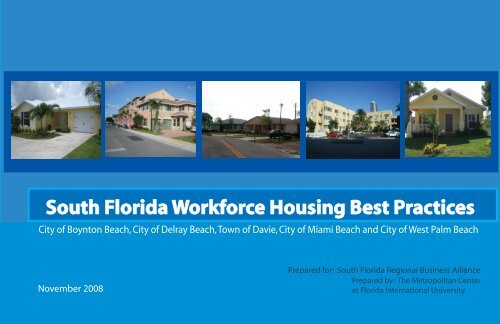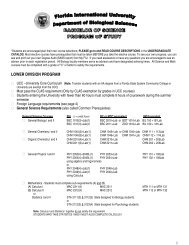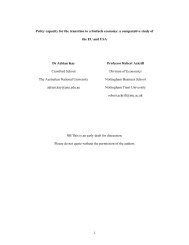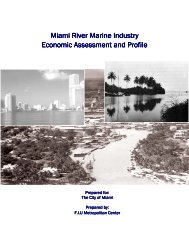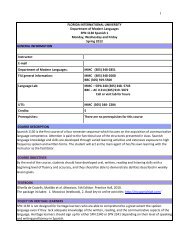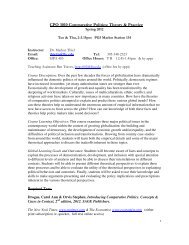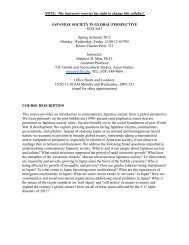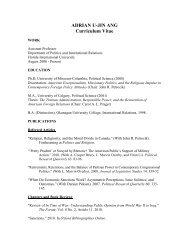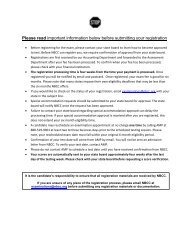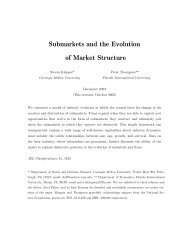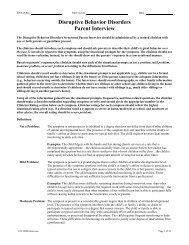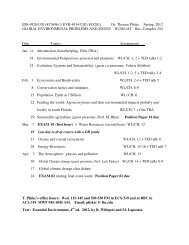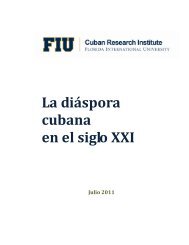South Florida Workforce Housing Best Practices
South Florida Workforce Housing Best Practices
South Florida Workforce Housing Best Practices
Create successful ePaper yourself
Turn your PDF publications into a flip-book with our unique Google optimized e-Paper software.
<strong>South</strong> <strong>Florida</strong> <strong>Workforce</strong> <strong>Housing</strong> <strong>Best</strong> <strong>Practices</strong><br />
City of Boynton Beach, City of Delray Beach, Town of Davie, City of Miami Beach and City of West Palm Beach<br />
November 2008<br />
Prepared for: <strong>South</strong> <strong>Florida</strong> Regional Business Alliance<br />
Prepared by: The Metropolitan Center<br />
at <strong>Florida</strong> International University
The <strong>South</strong> <strong>Florida</strong> Regional Business Alliance gratefully acknowledges the<br />
John D. and Catherine T. MacArthur Foundation<br />
for its support of regional partnerships and initiatives in the area of affordable and workforce housing.<br />
This regional study would not have been possible without their support.<br />
The <strong>South</strong> <strong>Florida</strong> Regional Business Alliance would also like to acknowledge the<br />
following organizations for their time and support of this regional effort.<br />
Broward <strong>Housing</strong> Partnership<br />
Broward Workshop<br />
Economic Council of Palm Beach County, Inc.<br />
FAU Center for Environmental and Urban Solutions<br />
FIU Metropolitan Center<br />
Greater Miami Chamber of Commerce & the Chamber's <strong>Workforce</strong> <strong>Housing</strong> Committee<br />
<strong>Housing</strong> Leadership Council of Palm Beach County, Inc.<br />
<strong>South</strong> <strong>Florida</strong> Regional Planning Council<br />
ULI <strong>South</strong>east <strong>Florida</strong> / Caribbean<br />
<strong>South</strong> <strong>Florida</strong> <strong>Workforce</strong> <strong>Housing</strong> <strong>Best</strong> <strong>Practices</strong><br />
Acknowledgements
Vivian Brooks, Assistant Director<br />
Community Redevelopment Agency<br />
City of Boynton Beach<br />
Hanna Matras, Senior Planner<br />
City of Boynton Beach<br />
Shirley Taylor-Prakelt, Director<br />
<strong>Housing</strong> and Community Development<br />
Town of Davie<br />
Diane Colonna, Executive Director<br />
Community Redevelopment Agency<br />
City of Delray Beach<br />
Roberto Datorre, Executive Director<br />
City of Miami Beach CDC<br />
Denis Russ, Director of Community Development<br />
City of Miami Beach CDC<br />
Terri Murray, Executive Director<br />
Northwood Renaissance<br />
City of West Palm Beach<br />
<strong>South</strong> <strong>Florida</strong> <strong>Workforce</strong> <strong>Housing</strong> <strong>Best</strong> <strong>Practices</strong><br />
Acknowledgements
Cover Design & Report Design and Layout:<br />
Candy Hurtado<br />
FIU Metropolitan Center Research Team<br />
Ned Murray, Ph.D., A.I.C.P., Associate Director, Principal Investigator<br />
Dario Moreno, Ph..D., Director<br />
Amanda Gorski, M.A., Research Associate<br />
Dario Gonzalez, M.A., Research Associate<br />
Victoria Lerma, M.A., Research Associate<br />
Candy Hurtado, Research Assistant<br />
Stephanie Smith, M.H.S.A., Research Assistant<br />
<strong>South</strong> <strong>Florida</strong> <strong>Workforce</strong> <strong>Housing</strong> <strong>Best</strong> <strong>Practices</strong>
Table of Contents<br />
<strong>South</strong> <strong>Florida</strong> <strong>Workforce</strong> <strong>Housing</strong> <strong>Best</strong> <strong>Practices</strong><br />
<strong>South</strong> <strong>Florida</strong>’s <strong>Best</strong> Practice in <strong>Workforce</strong> <strong>Housing</strong> 1<br />
A. Introduction 1<br />
B. The Municipal Scorecard for Affordable <strong>Housing</strong> Delivery© 2<br />
C. General Findings 3<br />
D. <strong>Best</strong> Practice Case Study Examples 4<br />
City of Boynton Beach <strong>Workforce</strong> <strong>Housing</strong> Redevelopment 5<br />
City of Delray Beach Community Land Trust 6<br />
Town of Davie Affordable <strong>Housing</strong> Policy 7<br />
City of Miami Beach Rental <strong>Housing</strong> Preservation 8<br />
<strong>Workforce</strong> <strong>Housing</strong> Policies and Strategies: Recommended Solutions 10<br />
A. Policy and Management 10<br />
B. Planning and Land Use 10<br />
C. Local Dedicated Funding 11<br />
D. Institutional Capacity-Building 11
A. Introduction<br />
<strong>South</strong> <strong>Florida</strong> <strong>Workforce</strong> <strong>Housing</strong> <strong>Best</strong> <strong>Practices</strong> is a companion study to the 2008 <strong>South</strong> <strong>Florida</strong> <strong>Workforce</strong><br />
<strong>Housing</strong> Needs Assessment. The study highlights the accomplishments of <strong>South</strong> <strong>Florida</strong> municipalities that<br />
have been proactive in addressing the workforce housing needs of their respective communities. The best<br />
practice case studies are the product of a “scorecard” assessment of affordable housing delivery among <strong>South</strong><br />
<strong>Florida</strong>’s county and municipal governments. The scorecards were prepared by the <strong>Florida</strong> International<br />
University Metropolitan Center on behalf of the Broward <strong>Housing</strong> Partnership (BHP) and <strong>Housing</strong> Leadership<br />
Council of Palm Beach County (HLC/PBC) as part of their workforce housing needs assessments. The<br />
Municipal Scorecard for Affordable <strong>Housing</strong> Delivery© (MS-AHD) model was created to monitor and evaluate<br />
<strong>South</strong> <strong>Florida</strong>’s workforce housing supply and affordability<br />
mismatch was exacerbated by speculative investment that<br />
resulted in multiple conversions of rental units to condominiums<br />
and an overall development trend in recent years toward a more<br />
upscale housing demand external to the local market<br />
<strong>South</strong> <strong>Florida</strong> <strong>Workforce</strong> <strong>Housing</strong> <strong>Best</strong> <strong>Practices</strong><br />
the progress of local governments in developing and implementing workforce/affordable housing policies and<br />
building management and institutional capacities to address these issues in the long-term.<br />
The MS-AHD implementation in Broward and Palm Beach Counties enabled the MC/FIU to assess the<br />
progress of the counties and larger municipalities during the past year. The MS-AHD also enabled the<br />
MC/AHD to highlight best practice examples in <strong>South</strong> <strong>Florida</strong> for other local governments to emulate and<br />
perhaps replicate within their local context. The following sections summarize the MS-AHD assessments in<br />
Broward and Palm Beach Counties and highlights specific workforce housing best practice efforts that have<br />
been initiated.<br />
1
B. The Municipal Scorecard for Affordable <strong>Housing</strong> Delivery©<br />
The Municipal Scorecard for Affordable <strong>Housing</strong> Delivery© (MS-AHD)<br />
model was created to provide a systematic and comprehensive<br />
approach toward the policy development, implementation and<br />
performance evaluation of workforce/affordable housing initiatives at the<br />
local level. The expectation is that in order for local governments to<br />
address the urgency, complexities and long-term commitment to<br />
workforce/affordable housing issues there is the need to institute a<br />
systematic, comprehensive and performance-based approach.<br />
The MS-AHD’s systematic and comprehensive approach is a “strategy”<br />
linked to a set of objectives (processes) and measures to evaluate<br />
performance (outcomes). The initial application of the MS-AHD model<br />
identified and mapped the lead indicators (processes) and guideposts<br />
to determine the extent to which local governments in <strong>South</strong> <strong>Florida</strong> had<br />
adopted systematic and comprehensive approaches to their<br />
workforce/affordable housing needs. The identification and mapping of<br />
lead indicators that serve as the “drivers” of performance is the critical<br />
first step in performance evaluation as lead indicators are predictive in<br />
nature.<br />
The following are the guiding principals of the MS-AHD model:<br />
1) Each municipality has a “resident workforce” that is integral to<br />
the character of each community and a “commuter workforce”<br />
that supports the local economy;<br />
2) The creation of an effective response to workforce/affordable<br />
housing needs requires solutions being developed and<br />
implemented at both the municipal and county levels of local<br />
government;<br />
3) An effective policy response will necessitate a coordinated and<br />
integrated approach to affordable housing production and<br />
preservation;<br />
4) Current federal and state programs are insufficient both in terms<br />
of funding and lack of coordination and integration with other<br />
important government layers that control or influence the<br />
delivery of affordable housing, including land use planning,<br />
zoning and community redevelopment activities; and<br />
5) Local workforce/affordable housing programs and initiatives<br />
must be performance-driven.<br />
Methodology<br />
The MS-AHD model consists of four (4) interrelated and mutuallysupporting<br />
workforce/affordable housing delivery “process criteria.” The<br />
four processes provide the basis for a systematic and comprehensive<br />
workforce/affordable housing delivery system. Together these<br />
processes aim to provide the essential policy skills and leadership,<br />
management commitment, dedicated funding and on-going institutional<br />
capacity-building to enable the successful development and<br />
implementation of a sustainable workforce/affordable housing delivery<br />
system. Further, the MS-AHD serves as a performance measurement<br />
tool that can evaluate the effectiveness of a municipality in designing<br />
and implementing a workforce/affordable housing delivery system. The<br />
expected outcome of this approach (strategy) should be a sustained<br />
level of workforce/affordable housing production and preservation.<br />
The Municipal Scorecard for<br />
Affordable <strong>Housing</strong> Delivery© Model<br />
Policy & Management<br />
Institution Building Planning & Land Use<br />
Dedicated Funding<br />
The MS-AHD methodology involves an assessment of current policies,<br />
plans and other initiatives that each municipality has adopted to<br />
address their workforce/affordable housing needs and issues. The<br />
assessment includes a review of each municipality’s Comprehensive<br />
Plan and recent Comprehensive Plan Evaluation and Appraisal Report<br />
(EAR). The review also includes HUD-Consolidated Plans, Local<br />
<strong>Housing</strong> Assistance Plans (LHAPs) and Community Redevelopment<br />
Area (CRA) Plans, where applicable. The methodology also includes<br />
an interview component with relevant city/town departments and<br />
agencies, including Planning and Zoning, <strong>Housing</strong> and Community<br />
Development and Community Redevelopment Agencies (CRAs).<br />
<strong>South</strong> <strong>Florida</strong> <strong>Workforce</strong> <strong>Housing</strong> <strong>Best</strong> <strong>Practices</strong><br />
1) Policy and Management Process<br />
Effective policy and professional management are inseparable in an<br />
effective affordable housing delivery system. Coherent policy direction<br />
and sound management practice are essential. Clear policy direction<br />
will include a commitment to professional management capacity and<br />
resources. Organizational and professional management capacity are<br />
important requisites for the effective planning and implementation of<br />
affordable housing strategies. An effective policy and management<br />
process for affordable housing delivery will demonstrate clear policy<br />
direction and professional management capacity resulting in<br />
measurable affordable housing production and preservation initiatives.<br />
Policy and Management Assessment<br />
The adoption of a comprehensive local workforce/affordable housing<br />
policy and the implementation of a coordinated and integrated housing<br />
management system are potential outcomes of an effective policy and<br />
management process. A comprehensive workforce/affordable housing<br />
policy must specifically address each of the other interrelated elements<br />
of the MS-AHD model – Planning and Land Use, Dedicated Funding,<br />
Institution Building. Therefore, the MS-AHD policy and management<br />
assessment would first determine whether a comprehensive and<br />
overarching workforce/affordable housing policy has been adopted, and<br />
secondly, whether the necessary professional management resources<br />
have been inputted to effectively support the implementation of the<br />
workforce/affordable housing policy.<br />
Absent a comprehensive local workforce/affordable housing policy, the<br />
MS-AHD assessment targets a municipality’s various housing subpolicies<br />
- HUD Consolidated Plan, Comprehensive Plan and<br />
Community Redevelopment Plan. The coordination and integration of<br />
these planning policies, including their level of management capacity,<br />
are critical in the State of <strong>Florida</strong> as together these plans currently<br />
determine the extent of workforce/affordable housing production and<br />
preservation at the municipal level.<br />
2) Planning and Land Use Process<br />
Effective planning and land use will contribute to both policy formulation<br />
and strategy implementation in an affordable housing delivery system.<br />
Planning will inform policy and then create appropriate land use<br />
changes to promote affordable housing development opportunities. As<br />
such, the MS-AHD model determines whether planning is being used<br />
as a vehicle for informing affordable housing policy decisions and a<br />
means for implementing affordable policy strategies. An effective<br />
planning and land use process for affordable housing delivery will also<br />
integrate workforce/affordable housing with related planning initiatives<br />
involving economic development, transportation and capital<br />
improvements.<br />
2
Planning and Land Use Assessment<br />
Land use and zoning changes that would provide new opportunities and<br />
incentives for affordable housing production and preservation are<br />
potential outcomes of an effective planning and land use process. A<br />
municipality’s Comprehensive Plan can be an effective tool for<br />
developing and implementing workforce/affordable housing policies and<br />
strategies. However, it is important that correlations are identified<br />
between the required <strong>Housing</strong> Element and other key elements of the<br />
Comprehensive Plan. Specifically, how do the policies and objectives<br />
of the <strong>Housing</strong> Element correlate with the policies and objectives of the<br />
Future Land Use, Public Facilities, Transportation and Capital<br />
Improvements Elements and certain “optional” elements such as<br />
Economic Development which can provide the necessary planning for<br />
expanded employment opportunities for the local workforce.<br />
The Planning and Land Use assessment also determines the level to<br />
which a municipality’s HUD Consolidated Plan, Local <strong>Housing</strong><br />
Assistance Plan (LHAP) and Community Redevelopment Area (CRA)<br />
Plan are coordinated and integrated with the Comprehensive Plan to<br />
provide clear visioning and strategies for workforce/affordable housing<br />
production and preservation. The HUD Consolidated Plan, LHAP and<br />
CRA Plan provide many of the important financing tools for<br />
workforce/affordable housing development.<br />
3) Dedicated Funding Process<br />
The MS-AHD model includes a process for developing and sustaining a<br />
local, dedicated funding source for workforce/affordable housing.<br />
<strong>Workforce</strong>/affordable housing policies and strategies must be supported<br />
by a long-term dedicated funding stream. A local dedicated funding<br />
source shows government commitment and an assurance that planned<br />
affordable housing opportunities are realized. A dedicated funding<br />
process for affordable housing delivery will also include support to<br />
county/city departments and other housing agencies responsible for<br />
implementing affordable housing policies and strategies.<br />
Dedicated Funding Assessment<br />
The establishment of a housing trust fund or a workforce/affordable<br />
bond issue are potential outcomes of a local dedicated funding process.<br />
Local dedicated funding includes long-term support for a variety of<br />
workforce/affordable housing development strategies including land<br />
acquisition, construction financing and housing<br />
rehabilitation/preservation. Dedicated funding also includes staff<br />
support for departments and agencies responsible for the planning and<br />
management of workforce/affordable housing programs and services<br />
including outside non-profit housing development organizations.<br />
The earmarking of CRA tax increment financing (TIF) funds is a<br />
potential “short-term” dedicated funding source for workforce/affordable<br />
housing development. While the funding is limited to designated<br />
community redevelopment areas, there is substantial flexibility in the<br />
use of TIF funds to support workforce/affordable housing development<br />
activities. Likewise, larger municipalities have access to various federal<br />
and state housing funds, e.g. Community Development Block Grant<br />
(CDBG), HOME, and State <strong>Housing</strong> Initiatives Program (SHIP), which<br />
can be piggybacked and combined with local housing financing tools to<br />
address workforce /affordable housing needs. Federal and State<br />
programs also provide support for the on-going planning and<br />
management of local housing programs. Newly allocated<br />
Neighborhood Stabilization Program (NSP) funds should also be<br />
targeted and leveraged with existing housing resources.<br />
4) Institution Building Process<br />
Institution building is seen as an important long-term process for<br />
addressing a community’s affordable housing needs. Sustainable<br />
affordable housing policy and strategies will include on-going<br />
institutional capacity building among local government, business and<br />
industry, educational institutions and community-based organization<br />
(CBOs). This effort includes the development of formal public/private<br />
partnerships and the collaboration of all key stakeholders. Institution<br />
building includes the development and leveraging of local financing<br />
resources, expanding the functions of non-profit housing organizations<br />
and the development of employer assisted housing (EAH) programs<br />
and strategies.<br />
Institution Building Assessment<br />
The formation and active engagement of working public/private<br />
partnerships involving key stakeholders and employer assisted housing<br />
(EAH) programs are potential outcomes of a local institution building<br />
process. The MS-AHD model determines the extent to which<br />
municipalities have formally engaged the private sector – business and<br />
industry - and community-based nonprofit organizations in developing<br />
and implementing workforce/affordable housing policies and strategies.<br />
The model also assesses the extent to which individual municipalities<br />
have expanded in-house capacity to improve the management of<br />
workforce/affordable housing programs, including the leveraging of local<br />
financing resources with non-profit housing developers and private<br />
lending consortia.<br />
C. General Findings<br />
<strong>South</strong> <strong>Florida</strong> <strong>Workforce</strong> <strong>Housing</strong> <strong>Best</strong> <strong>Practices</strong><br />
As previously noted, the MS-AHD model was applied in both Broward<br />
and Palm Beach Counties as part of the 2007 Affordable <strong>Housing</strong><br />
Market Updates prepared on behalf of the Broward <strong>Housing</strong> Partnership<br />
(BHP) and <strong>Housing</strong> Leadership Council of Palm Beach County<br />
(HLC/PBC). The following is a summation of the key findings:<br />
Policy and Management Assessment<br />
∗ County and municipal governments in Broward and Palm Beach<br />
Counties lack a comprehensive and systematic policy approach<br />
to workforce/affordable housing issues;<br />
∗ While lacking a comprehensive and systematic approach, a<br />
significant number of local governments have begun to address<br />
their workforce/affordable housing needs through policy<br />
changes within the Comprehensive Plan, including recent EARbased<br />
amendments;<br />
∗ Most local governments do not effectively integrate changes to<br />
the <strong>Housing</strong> Element of their Comprehensive Plans with other<br />
critical elements such as Future Land Use, Public Facilities,<br />
Transportation, Economic (optional) and Capital Improvements;<br />
∗ Few local governments correlate policy initiatives in their<br />
Comprehensive Plans with housing and development policies<br />
within their respective HUD Consolidated Plans, Local <strong>Housing</strong><br />
Assistance Plans (LHAPs) and Community Redevelopment<br />
Area (CRA) Plans;<br />
∗ The local delivery of workforce/affordable housing policies and<br />
programs are typically fragmented among each local<br />
government’s <strong>Housing</strong> and Community Development and<br />
Planning & Zoning Departments and Community<br />
Redevelopment Agencies (CRAs);<br />
∗ Combining in-house management and operational functions is<br />
generally problematic in local affordable housing delivery<br />
systems;<br />
∗ Local governments that have made progress in addressing their<br />
workforce/affordable housing needs demonstrate a discernible<br />
level of coordination and communication among key<br />
departments and agencies;<br />
3
∗ While many local governments have instituted “expedited”<br />
permitting processes, a comprehensive single-application<br />
process for workforce/affordable projects is non-existent; and<br />
∗ Several local governments “fund” impact fee waivers for<br />
workforce/affordable housing projects, but actual impact fee<br />
waivers are prohibited by state government regulation.<br />
Planning and Land Use Assessment<br />
∗ Local governments that have made strides in addressing their<br />
workforce/affordable housing needs have generally undertaken<br />
coordinated, inter-departmental and inter-agency planning<br />
efforts to implement their workforce/affordable housing polices;<br />
∗ Coordinated and integrated planning efforts generally include<br />
recent EAR-based amendments involving Future Land Use and<br />
Transportation Elements and accompanying Unified Land<br />
Development Regulations;<br />
∗ Local governments that have been pro-active in<br />
workforce/affordable housing production have inventoried and<br />
identified publicly-owned real property in accordance with<br />
Chapter 166.0451, <strong>Florida</strong> Statutes, Disposition of Municipal<br />
Property for Affordable <strong>Housing</strong>;<br />
∗ Effective planning coordination and integration typically includes<br />
HUD Consolidated Plans, Local <strong>Housing</strong> Assistance Plans<br />
(LHAPs) and Community Redevelopment Area (CRA) Plans;<br />
∗ Local governments have not effectively addressed economic<br />
and industrial planning issues in conjunction with their<br />
workforce/affordable housing policies and initiatives; and<br />
∗ Several local governments have made efforts to expand mixeduse<br />
and transit oriented development (TOD) opportunities to<br />
accommodate economic development and mixed-income,<br />
workforce housing projects.<br />
Dedicated Funding Assessment<br />
∗ Few local governments have developed a local dedicated<br />
funding source for affordable housing, instead relying on<br />
traditional federal and state funding, e.g. CDBG, HOME, SHIP<br />
for affordable housing;<br />
∗ Local governments that have made strides in addressing their<br />
workforce/affordable housing needs have typically earmarked<br />
CRA tax increment financing (TIF) funds toward projects;<br />
∗ Several local governments have effectively piggybacked various<br />
federal and state housing funds, e.g. CDBG, HOME, and SHIP,<br />
with local housing financing tools, including TIF funds, to<br />
address their workforce/affordable housing needs;<br />
∗ Local workforce/affordable housing programs are principally<br />
designed to assist first-time homebuyers with substantial<br />
mortgage subsidies; and<br />
∗ There is little evidence that local governments have given<br />
priority to workforce/affordable housing programs aimed at<br />
purchase/rehabilitation, rental rehabilitation or targeted<br />
neighborhood revitalization.<br />
Institution Building Assessment<br />
∗ While <strong>South</strong> <strong>Florida</strong>’s workforce/affordable housing policy issues<br />
have been effectively articulated and promoted through the<br />
efforts of the Broward <strong>Housing</strong> Partnership, Greater Miami<br />
Chamber of Commerce and <strong>Housing</strong> Leadership Council of<br />
Palm Beach County, working private/public partnerships that<br />
advance and sustain workforce/affordable housing production<br />
has not been developed;<br />
∗ Several local governments through their planning and<br />
community development departments and CRAs have made<br />
significant strides working with community-based organizations<br />
such as community land trusts (CLTs) and community<br />
development corporations (CDCs) in developing and preserving<br />
workforce/affordable housing;<br />
<strong>South</strong> <strong>Florida</strong> <strong>Workforce</strong> <strong>Housing</strong> <strong>Best</strong> <strong>Practices</strong><br />
∗ While there are several good examples in place in <strong>South</strong> <strong>Florida</strong><br />
of local government working effectively with non-profit housing<br />
developers, e.g. CLTs, CDCs, this capacity is largely<br />
undeveloped;<br />
∗ Several local governments, through their community<br />
development departments and CRAs, have been successful in<br />
developing local lending consortia to help finance<br />
workforce/affordable housing initiatives;<br />
∗ Employer Assisted <strong>Housing</strong> (EAH) initiatives are generally<br />
undeveloped and the private/public collaboratives that are<br />
necessary for their success have not been established;<br />
∗ The effective leveraging of local financing resources with<br />
federal, state and other local public and private resources is an<br />
undeveloped institutional capacity.<br />
D. <strong>Best</strong> Practice Case Study Examples<br />
The following best practice case studies were chosen to demonstrate<br />
how successful workforce/affordable housing projects were developed<br />
in <strong>South</strong> <strong>Florida</strong>. Case studies were selected that provide the clearest<br />
evidence of how a more comprehensive and integrated housing delivery<br />
system can effectively implement workforce/affordable housing policies<br />
and objectives. The case studies focus on specific housing projects<br />
and the policies and management capacities that were critical to there<br />
success. Four of the projects were identified in the MS-AHD<br />
assessment of Broward and Palm Beach Counties. The fifth project,<br />
Miami Beach Rental <strong>Housing</strong> Preservation, was included in the Design<br />
Institute at Abacoa’s 2007 focus on workforce/affordable housing in<br />
<strong>South</strong> <strong>Florida</strong>.<br />
4
City of Boynton Beach<br />
<strong>Workforce</strong> <strong>Housing</strong> Redevelopment<br />
Boynton Beach serves as a <strong>South</strong> <strong>Florida</strong> best practice case study for<br />
workforce housing redevelopment. The Boynton Beach Community<br />
Redevelopment Agency (CRA) partnered with a private developer, the<br />
Cornerstone Group, to include affordable housing at The Preserve, a<br />
master–planned luxury condominium and townhome community. The<br />
Preserve consists of 180 two and three-story townhouses with 50<br />
workforce housing units designated for households earning less than<br />
120 percent of AMI. Through a joint financing effort, income eligible<br />
homebuyers can qualify for as much as $160,000 in financial assistance<br />
on a condominium or townhouse. The CRA estimates that with up to<br />
$60,000 in developer contributions, up to $50,000 in SHIP funds and a<br />
potential $50,000 from the CRA’s Homebuyer’s Assistance Program,<br />
the price on a $279,990 three-bedroom condominium can be reduced to<br />
as low as $119,990.<br />
The City of Boynton Beach has demonstrated a high-level of<br />
coordination and integration through the Department of Development<br />
which combines the City’s Planning and Zoning and Community<br />
Improvement Divisions (CDBG Administration) under one roof. There is<br />
also a good working relationship between the City’s Department of<br />
Development and the Community Redevelopment Agency (CRA). The<br />
two departments have worked effectively together in the planning and<br />
implementation of the City’s <strong>Workforce</strong> <strong>Housing</strong> Program.<br />
The Boynton Beach CRA has been active in other workforce housing<br />
infill projects including providing a $3 million land write-down for Ocean<br />
Breeze, a mixed-income development consisting of 84 rental units for<br />
low- and moderate-income household and 56 townhome units. The<br />
CRA has also partnered with the Boynton Beach Faith-Based CDC to<br />
create three new homes in the Heart of Boynton neighborhood. The<br />
CRA sold the CDC the land for $10 in exchange for affordability,<br />
upgraded design and energy efficiency.<br />
The Boynton Beach CRA has been active in<br />
other workforce housing infill projects<br />
including providing a $3 million land writedown<br />
for Ocean Breeze, a mixed-income<br />
development consisting of 84 rental units for<br />
low and moderate income household and 56<br />
town home units<br />
Urban Infill: The Preserve<br />
<strong>South</strong> <strong>Florida</strong> <strong>Workforce</strong> <strong>Housing</strong> <strong>Best</strong> <strong>Practices</strong><br />
5
City of Delray Beach<br />
Community Land Trust<br />
Delray Beach serves as a <strong>South</strong> <strong>Florida</strong> best practice case study for its<br />
creation and support of the Delray Beach Community Land Trust (CLT).<br />
The creation of the Delray Beach Community Land Trust (CLT) was a<br />
key recommendation of the SW Neighborhood Redevelopment Plan<br />
adopted by the City Commission in 2003. The CLT was developed as a<br />
long-term solution to eliminating barriers to affordability in housing by<br />
providing an affordable housing stock within the City in perpetuity. The<br />
CRA put forth more than $4,000,000 in funding to support the CLT<br />
during FY 2006-2007. During FY 2005-2006 the City and CRA<br />
transferred deeds on nineteen (19) lots to the CLT to utilize as part of<br />
the affordable housing inventory. In July of 2006, the City transitioned<br />
its First Time Homebuyer Program, which provided traditional down<br />
payment assistance, into a Sub-recipient Partnership Program with the<br />
Community Land Trust for the purpose of creating even more affordable<br />
purchase prices. Under the Sub-recipient <strong>Housing</strong> Partnership<br />
Program, subsidy is awarded (based on occupants income eligibility) to<br />
the CLT to be applied towards the principal reduction of construction<br />
costs of each eligible unit. This strategy enhances each unit’s<br />
affordability by keeping the subsidy attached to the unit as opposed to<br />
the occupant to ensure affordability in perpetuity.<br />
The CLT receives funding allocations from the Community<br />
Redevelopment Agency’s (CRA) tax increment financing (TIF) fund and<br />
State <strong>Housing</strong> Initiatives Partnership (SHIP) to produce workforce<br />
housing units that will remain affordable for future homebuyers. The<br />
City’s Family/<strong>Workforce</strong> <strong>Housing</strong> policy emphasizes the integration of<br />
workforce units into market rate developments. Recent modifications to<br />
the Family/<strong>Workforce</strong> <strong>Housing</strong> Ordinance give the CLT first right-ofrefusal<br />
when workforce units that have been built by private developers<br />
are put up for sale. Significant coordination and integration exist among<br />
these three departments and the Delray Beach Community Land Trust<br />
in the planning and implementation of the City’s Family/<strong>Workforce</strong><br />
<strong>Housing</strong> Ordinance. The City of Delray Beach has committed<br />
Community Redevelopment Agency (CRA) tax increment financing<br />
(TIF) funds to augment workforce housing development projects. TIF<br />
and SHIP funds are combined to produce affordable first-time<br />
homebuyer units in conjunction with the Delray Beach Community Land<br />
Trust (CLT). A total of $492,433 in SHIP funds were allocated in Fiscal<br />
Year 2006-2007 for first-time homebuyer assistance with the subsidy<br />
attached to the housing unit through the CLT. The CLT homebuyer<br />
program produced and closed-on ten (10) units in 2007 that are<br />
dedicated to low and moderate income homebuyers. Additionally, both<br />
TIF and SHIP funds ($500,000) were used to acquire and convert the<br />
historic La France Hotel into 14 affordable apartment units.<br />
Community Land Trust Purchase/ Rehabilitation<br />
<strong>South</strong> <strong>Florida</strong> <strong>Workforce</strong> <strong>Housing</strong> <strong>Best</strong> <strong>Practices</strong><br />
Community Land Trust Purchase/ Rehabilitation<br />
Delray Beach serves as a <strong>South</strong> <strong>Florida</strong> <strong>Best</strong><br />
Practice case study for its creation and support<br />
of the Delray Beach Community Land Trust<br />
Swinton Community Land Trust: Single-Family Development<br />
6
Town of Davie<br />
Affordable <strong>Housing</strong> Policy<br />
The Town of Davie serves as a <strong>South</strong> <strong>Florida</strong> best practice case study<br />
for the adoption of affordable housing/inclusionary zoning ordinance<br />
and management capacity. The Town’s passed its first omnibus<br />
affordable housing/inclusionary zoning ordinance on April 16 2008. The<br />
goal of the ordinance is “to provide new, sanitary, and sustainable<br />
housing by mandating that all new residential developments with 10<br />
units or greater must set aside 20 percent of the units as affordable<br />
housing or pay into a trust fund. The fee would ask $9.00 per square<br />
foot not to exceed 1,600 sq ft ($14,100) in a plan which mirrors the<br />
bonus density code of Broward County.<br />
The Town of Davie has a high level of coordination and integration<br />
among key departments involved with the delivery of affordable housing<br />
programs. There is a good working relationship among the<br />
departments of <strong>Housing</strong> and Community Development, Planning &<br />
Zoning and Engineering which guide housing development applications<br />
through the process and waive every fee for affordable housing except<br />
water and sewer impact fees which are mitigated using SHIP funds. To<br />
expedite the permitting process the Town created the Development<br />
Services Department which is comprised of Planning & Zoning,<br />
Occupational License, Engineering and Code Enforcement. If a plan<br />
has at least one affordable housing unit it receives a “red sticker” and is<br />
“hand walked” through the permitting process by the <strong>Housing</strong> and<br />
Community Development Director. The Director of <strong>Housing</strong> and<br />
Community Development carefully reviews all prospective affordable<br />
housing projects to verify their level of benefit and period of affordability.<br />
The waiver of all fees, e.g. Parks and Recreations Impact Fees, Design<br />
Review and Site Plan Processing Fees, Engineering Review Fees,<br />
Building Permit Fees, etc., are based on this review.<br />
The Town of Davie has demonstrated a significant level of “in-house”<br />
capacity-building in advancing its affordable housing policies and<br />
programs. Capacity-building is found in the Town’s <strong>Housing</strong> and<br />
Community Development and Planning and Zoning Departments.<br />
Within the past 3 years the Town has shown the ability to effectively<br />
leverage local funding sources with federal and state housing<br />
resources. For example, the Town has effectively leveraged $1.3<br />
million in tax increment financing (TIF) funds and private financing to<br />
build twenty-two (22) affordable housing units through Habitat for<br />
Humanity. The Town was creative in leveraging $500,000 from the<br />
Broward County <strong>Housing</strong> Authority with donated services from the<br />
Children Services Council and Memorial Health Care Systems (MHS) in<br />
renovating the Ehlinger public housing project.<br />
The Town of Davie has demonstrated an effective and efficient use of<br />
federal, state and local funds in addressing their affordable housing<br />
needs. The Town effectively leverages local funds e.g. tax increment<br />
financing (TIF) and the Community Endowment Fund (CEF) with HUD<br />
Community Development Block Grant (CDBG) and HOME funds and<br />
State <strong>Housing</strong> Incentives Program (SHIP) funds. The Town of Davie<br />
also uses $130,818 in CDBG funds for Fair <strong>Housing</strong>, Citizen<br />
Participation & Support Services to expand Fair <strong>Housing</strong> Education &<br />
Outreach Programs designed to remove impediments to fair housing<br />
choices and provide a wide range of housing opportunities for Davie<br />
residents.<br />
<strong>South</strong> <strong>Florida</strong> <strong>Workforce</strong> <strong>Housing</strong> <strong>Best</strong> <strong>Practices</strong><br />
The Town of Davie has a high level of<br />
coordination and integration among key<br />
departments involved with the delivery of<br />
affordable housing programs.<br />
7
City of Miami Beach<br />
Rental <strong>Housing</strong> Preservation<br />
Miami Beach serves as a <strong>South</strong> <strong>Florida</strong> best practice case study for<br />
rental housing preservation. The first three projects included the<br />
historic Allen Apartment Hotel, London House and Barclay Plaza Hotel.<br />
The projects were undertaken by the Miami Beach Community<br />
Development Corporation (MBCDC) in collaboration with the City of<br />
Miami Beach and City of Miami Beach CRA. The projects will provide<br />
affordable housing opportunities for low- to moderate-income renters in<br />
Miami Beach (including workforce housing and housing for artists and<br />
cultural workers). The MBCDC reconfigured the units to provide a mix<br />
of efficiencies and studios, and one-, two-, and three-bedroom units.<br />
The configuration and rents of the units are designed to meet the<br />
increasing need for multi-bedroom rental units (a current gap in the<br />
housing supply) that are affordable to lower income residents. <strong>Housing</strong><br />
studies show that 70 percent of Miami Beach residents are employed in<br />
low-wage service industries and 60 percent of residents make less than<br />
$32,000 per year.<br />
The three project buildings were purchased for $13.7 million using City<br />
of Miami Beach CRA tax increment financing (TIF) funds. The Allen<br />
Apartment Hotel is located on a 9,625-square foot parcel and contains<br />
42 units with an average size of 255 square feet. Currently the building<br />
is vacant and boarded up. When reconstruction is completed, the<br />
building will contain 23 units.<br />
The Barclay Plaza Hotel is located on a 26,250-square foot site and<br />
contains 66 efficiency units averaging 267 square feet in size. At<br />
present, the Barclay Plaza Hotel is primarily occupied by low-income<br />
elderly residents, which means that most residents would likely qualify<br />
for affordable housing assistance when the units are rehabilitated.<br />
When construction is completed, the Barclay will contain 33 units. The<br />
London House is located on a 12,073-square foot site and contains 54<br />
units averaging 252 square feet in size. Like the Barclay Plaza Hotel,<br />
the London House is occupied as low-income rental housing. When<br />
reconstruction is completed, the building will contain approximately 31<br />
units. The MBCDC has incorporated “Green Communities” criteria into<br />
the building designs which promote public health, energy conservation,<br />
operational savings and sustainable building practices in affordable<br />
housing design.<br />
The MBCDC is also involved with other rental housing preservation<br />
projects including the 36 unit Villa Matti Apartments and 34-unit Villa<br />
Maria Apartments. These projects have been undertaken by the Miami<br />
Beach Community Development Corporation (MBCDC) working in<br />
partnership with the City of Miami Beach and Miami-Dade County.<br />
Sources of funds for the Villa Matti Apartments include HUD Section<br />
202, Miami-Dade County HOME and HODAG and City of Miami Beach<br />
CHDO funds. The Villa Maria Apartments were funded with City of<br />
Miami Beach HOME, SHIP and CDBG funds and Miami-Dade County<br />
HOME and Surtax funds.<br />
London House in Miami Beach<br />
<strong>South</strong> <strong>Florida</strong> <strong>Workforce</strong> <strong>Housing</strong> <strong>Best</strong> <strong>Practices</strong><br />
The projects will provide affordable housing<br />
opportunities for low- to moderate-income renters<br />
in Miami Beach (including workforce housing and<br />
housing for artists and cultural workers)<br />
Allen Apartment Hotel in Miami Beach<br />
8
City of West Palm Beach<br />
Model Block<br />
The Model Block Program in the Northwood community of West Palm<br />
Beach serves as a <strong>South</strong> <strong>Florida</strong> best practice case study for<br />
neighborhood revitalization through affordable housing development. In<br />
the Model Block Program, a likely block or two is identified for<br />
comprehensive improvements such as infrastructure improvements,<br />
addition of attractive street lighting and green landscape improvements<br />
along with the purchase and rehabilitation or new construction of homes<br />
that are affordable to low- to moderate-income first-time homebuyers. It<br />
is often difficult to attract homebuyers to urban areas with an aging<br />
infrastructure, large number of absentee owners and deteriorated<br />
housing. The Model Block Program provides visible targeted<br />
comprehensive improvements attracting first-time homebuyers and<br />
creating a positive ripple effect on other revitalization efforts across a<br />
wider area.<br />
“Miracle on 34 th Street”, the first Model Block Project in Palm Beach<br />
County, was undertaken by Neighborhood Renaissance, Inc. (formerly<br />
known as Northwood Renaissance) in collaboration among <strong>South</strong><br />
<strong>Florida</strong> LISC, the City of West Palm Beach and local developer,<br />
Complete Property Management, resulting in the purchase,<br />
rehabilitation and resale of nine (9) mission style homes, façade<br />
improvements to adjacent homes along with street improvements, traffic<br />
calming, lush landscaping, and the installation of attractive street<br />
lighting. Model Block II was a continuation of Model Block I and<br />
expanded improvements to the 600 blocks of 32 nd & 33 rd Streets.<br />
Phase III incorporated a Community Land Trust component to ensure<br />
that the newly built <strong>Florida</strong>-style bungalow homes remain affordable to<br />
future generations to come. In all, the Model Block Program resulted in<br />
33 affordable home ownership opportunities for low- to moderateincome<br />
families and an $8 million investment in the neighborhood.<br />
Funding sources include City of West Palm Beach HOME & CDBG,<br />
Palm Beach County SHIP, and Knight Foundation homebuyer grants<br />
administered through LISC.<br />
<strong>South</strong> <strong>Florida</strong> <strong>Workforce</strong> <strong>Housing</strong> <strong>Best</strong> <strong>Practices</strong><br />
In all, the Model Block Program resulted in 33<br />
affordable home ownership opportunities for<br />
low- to moderate-income families and an $8 million<br />
investment in the neighborhood<br />
9
<strong>Workforce</strong> <strong>Housing</strong> Policies and Strategies: Recommended Solutions<br />
This section provides recommended workforce housing policies and<br />
strategies that build on the findings of the Municipal Scorecard for<br />
Affordable <strong>Housing</strong> Delivery© (MS-AHD) best practice case studies.<br />
The recommended policies and strategies are divided into the<br />
four elements of the MS-AHD model:<br />
o Policy and Management<br />
o Planning and Land Use<br />
o Local Dedicated Funding<br />
o Institutional Capacity Building<br />
A. Policy and Management<br />
Creation of a Comprehensive Regional <strong>Workforce</strong> <strong>Housing</strong><br />
Policy<br />
A comprehensive “<strong>South</strong> <strong>Florida</strong> Regional <strong>Workforce</strong> <strong>Housing</strong><br />
Policy” should be formulated that addresses the findings of this<br />
study and the outcomes of the <strong>South</strong> <strong>Florida</strong> Regional <strong>Housing</strong><br />
Conference. The <strong>South</strong> <strong>Florida</strong> Regional <strong>Workforce</strong> <strong>Housing</strong><br />
Policy be considered for incorporation into the <strong>Housing</strong> Element<br />
of the <strong>South</strong> <strong>Florida</strong> Strategic Regional Policy Plan (SRPP).<br />
Creation of a Regional Affordable <strong>Housing</strong><br />
Delivery System<br />
The <strong>South</strong> <strong>Florida</strong> Regional <strong>Workforce</strong> <strong>Housing</strong> Policy should be<br />
implemented through a comprehensive “workforce housing<br />
delivery system” that would include the four (4) elements of the<br />
MS-AHD model. The creation of a regional workforce housing<br />
delivery system will help ensure the effective coordination and<br />
integration of <strong>South</strong> <strong>Florida</strong>’s workforce housing planning and<br />
management activities. Community-based, private/public<br />
partnerships would serve as the organizational vehicle for the<br />
workforce housing delivery system’s operation and<br />
implementation. Mission-driven public/private housing<br />
partnerships will help to maximize and effectively apply public<br />
and private sector resources by de-politicizing program delivery<br />
and differentiating administrative and operational functions<br />
within the larger workforce housing delivery system.<br />
Creation of a Comprehensive Single Permit Process for<br />
<strong>Workforce</strong> <strong>Housing</strong> Projects<br />
A “Comprehensive Permit” process is recommended to fully<br />
expedite the approval of proposed workforce/affordable housing<br />
projects subject to compliance with local and regional<br />
workforce/affordable housing goals and objectives. The<br />
Comprehensive Permit would involve a single application by<br />
project proponents for all local approvals, e.g. zoning, site plan<br />
review, etc. with a time certain for project approval.<br />
Implementation of a Performance Measurement System<br />
The design of the <strong>South</strong> <strong>Florida</strong> <strong>Workforce</strong> <strong>Housing</strong> Delivery<br />
System should include a performance measurement system to<br />
provide accountability in the management and implementation of<br />
the <strong>South</strong> <strong>Florida</strong> Regional <strong>Workforce</strong> <strong>Housing</strong> Delivery System.<br />
Policy Emphasis on Rental <strong>Housing</strong> Preservation<br />
and Production<br />
A comprehensive <strong>South</strong> <strong>Florida</strong> “Rental <strong>Housing</strong> Preservation<br />
Policy” initiative is recommended to address the pressing need<br />
of working households earning 80 percent or less than the area<br />
median income (AMI). Specific housing policy goals and<br />
objectives, rental program designs and funding allocations need<br />
to be identified to help preserve and expand this critical<br />
workforce housing supply.<br />
B. Planning and Land Use<br />
Coordination and Integration of <strong>Workforce</strong>/Affordable<br />
<strong>Housing</strong> Plans<br />
<strong>South</strong> <strong>Florida</strong> counties and municipalities should coordinate and<br />
integrate the workforce/affordable housing planning and policy<br />
initiatives set forth in their Comprehensive Plans, HU<br />
Consolidated Plans, State Local <strong>Housing</strong> Assistance Plans<br />
(LHAPs) to specifically address the need for<br />
workforce/affordable housing.<br />
<strong>South</strong> <strong>Florida</strong> <strong>Workforce</strong> <strong>Housing</strong> <strong>Best</strong> <strong>Practices</strong><br />
Create New Planning Objectives and Program Activities for<br />
<strong>Workforce</strong>/Affordable <strong>Housing</strong><br />
<strong>South</strong> <strong>Florida</strong> counties and municipalities should provide specific<br />
planning objectives and program activities within their HUD<br />
Consolidated Plans and State Local <strong>Housing</strong> Assistance Plans<br />
(LHAPs) to address the production and preservation of<br />
workforce/affordable rental housing.<br />
Community Redevelopment Area (CRA) Planning for<br />
<strong>Workforce</strong>/Affordable <strong>Housing</strong><br />
<strong>South</strong> <strong>Florida</strong> municipalities with Community Redevelopment<br />
Area (CRA) Plans should include specific policies and strategies<br />
for developing workforce/affordable housing, including mixedincome<br />
rental housing.<br />
Aggressive Urban Infill Strategies for <strong>Workforce</strong>/Affordable<br />
<strong>Housing</strong><br />
<strong>South</strong> <strong>Florida</strong> counties and municipalities should forge working<br />
partnerships with profit and non-profit housing organizations to<br />
go beyond the basic requirements of Chapter 166.0451, <strong>Florida</strong><br />
Statutes, Disposition of Municipal Property for Affordable<br />
<strong>Housing</strong>, and facilitate more aggressive urban infill strategies<br />
utilizing existing government-owned land to accommodate future<br />
workforce/affordable.<br />
Land Use and Zoning Incentives for <strong>Workforce</strong>/Affordable<br />
<strong>Housing</strong><br />
<strong>South</strong> <strong>Florida</strong> counties and municipalities should provide policies<br />
and objectives in the Future Land Use Element of their<br />
Comprehensive Plans and amendments to the Unified Land<br />
Development Regulations that encourage and enable<br />
workforce/affordable housing development opportunities<br />
including: density relief, expansion of multi-family residential<br />
districts and reductions in parking requirements.<br />
Ensure no “Net Loss” of Existing Rental <strong>Housing</strong> Supply<br />
<strong>South</strong> <strong>Florida</strong> counties and municipalities should add policy<br />
provisions to the <strong>Housing</strong> Element of the Comprehensive Plan<br />
that all future development will not result in a “net loss” of<br />
existing workforce/affordable rental housing for households<br />
earning 80 percent or less than the area median income (AMI).<br />
10
C. Local Dedicated Funding<br />
Create Local Public/ Private Dedicated Funding Sources for<br />
<strong>Workforce</strong>/Affordable <strong>Housing</strong><br />
<strong>South</strong> <strong>Florida</strong> counties and municipalities should create local<br />
public/private dedicated funding sources in support of<br />
workforce/affordable housing projects and program activities.<br />
Potential funding sources include: housing trust funds (non-<br />
SHIP), bond issues and tax increment financing (TIF) funds.<br />
Leverage Local Private Funds with Federal, State and Local<br />
Public Funds<br />
<strong>South</strong> <strong>Florida</strong> counties and municipalities should create locally<br />
designed workforce/affordable housing programs that effectively<br />
leverage local financing with federal and state housing grant<br />
programs including CDBG, HOME, SHIP and newly allocated<br />
Neighborhood Stabilization Program (NSP) funding.<br />
Target <strong>Workforce</strong>/Affordable <strong>Housing</strong> Funds to<br />
Neighborhood Revitalization<br />
<strong>Workforce</strong>/affordable housing funding should be targeted to<br />
comprehensive neighborhood revitalization efforts that include<br />
public infrastructure investments, code enforcement and<br />
increased crime prevention.<br />
Funding Emphasis on Purchase/Rehabilitation and Rental<br />
Rehabilitation Activities<br />
<strong>South</strong> <strong>Florida</strong> counties and municipalities should re-direct<br />
workforce/affordable housing funding away from deep subsidy,<br />
first time homebuyer programs to targeted neighborhood<br />
purchase/rehabilitation and investor-owned, rental rehabilitation<br />
programs.<br />
Pre-development Funding Support for Non-Profit<br />
<strong>Workforce</strong>/Affordable <strong>Housing</strong> Development Organizations<br />
<strong>South</strong> <strong>Florida</strong> counties and municipalities should provide predevelopment<br />
funding assistance to able non-profit housing<br />
organizations, including community land trusts (CLTs) and<br />
community development corporations (CDCs), to increase<br />
workforce/affordable housing development opportunities in<br />
targeted neighborhoods.<br />
D. Institutional Capacity-Building<br />
Support Private-Public <strong>Housing</strong> Partnerships in<br />
Implementing <strong>South</strong> <strong>Florida</strong>’s <strong>Workforce</strong> <strong>Housing</strong> Delivery<br />
<strong>South</strong> <strong>Florida</strong>’s workforce housing delivery should be<br />
operationalized through new and existing private-public housing<br />
partnerships. <strong>Housing</strong> partnerships should serve as<br />
intermediaries between local governments and communities in a<br />
workforce/affordable housing delivery system.<br />
Develop a Regional <strong>Workforce</strong> <strong>Housing</strong> Lending/Equity<br />
Investment Consortium<br />
Develop a Regional <strong>Workforce</strong> <strong>Housing</strong> Lending/Equity<br />
Consortium to provide financing assistance for local workforce<br />
housing program initiatives involving purchase/rehabilitation and<br />
rental housing preservation.<br />
Support for Employer Assisted <strong>Housing</strong> (EAH) Programs<br />
Institutional capacity-building for long term workforce/affordable<br />
housing development in <strong>South</strong> <strong>Florida</strong> will require the creation<br />
and support of Employer Assisted <strong>Housing</strong> Programs.<br />
Capacity-Building for Non-Profit <strong>Housing</strong><br />
Development Organizations<br />
<strong>South</strong> <strong>Florida</strong> counties and municipalities should provide<br />
financial support to capacity-building efforts of non-profit housing<br />
developments organizations, including community land trusts<br />
(CLTs) and community development corporations (CDCs).<br />
Alternative Funding Sources for Affordable/<br />
<strong>Workforce</strong> <strong>Housing</strong><br />
<strong>South</strong> <strong>Florida</strong> counties and municipalities should seek out or<br />
create alternative funding sources for workforce/affordable<br />
housing. The creation of local housing trust funds and the use<br />
of the New Market Tax Credits program to acquire, rehabilitate<br />
and re-sell foreclosed homes (REOs) are examples of<br />
alternative funding mechanisms<br />
.<br />
<strong>South</strong> <strong>Florida</strong> <strong>Workforce</strong> <strong>Housing</strong> <strong>Best</strong> <strong>Practices</strong><br />
Support Alternative Building Designs and Materials for<br />
<strong>Workforce</strong>/Affordable <strong>Housing</strong><br />
<strong>South</strong> <strong>Florida</strong> counties and municipalities should support<br />
alternative building designs and materials including “green”<br />
building methods, which could reduce the costs of<br />
workforce/affordable housing development.<br />
11


